SGS3.1 - Curriculum Support
advertisement
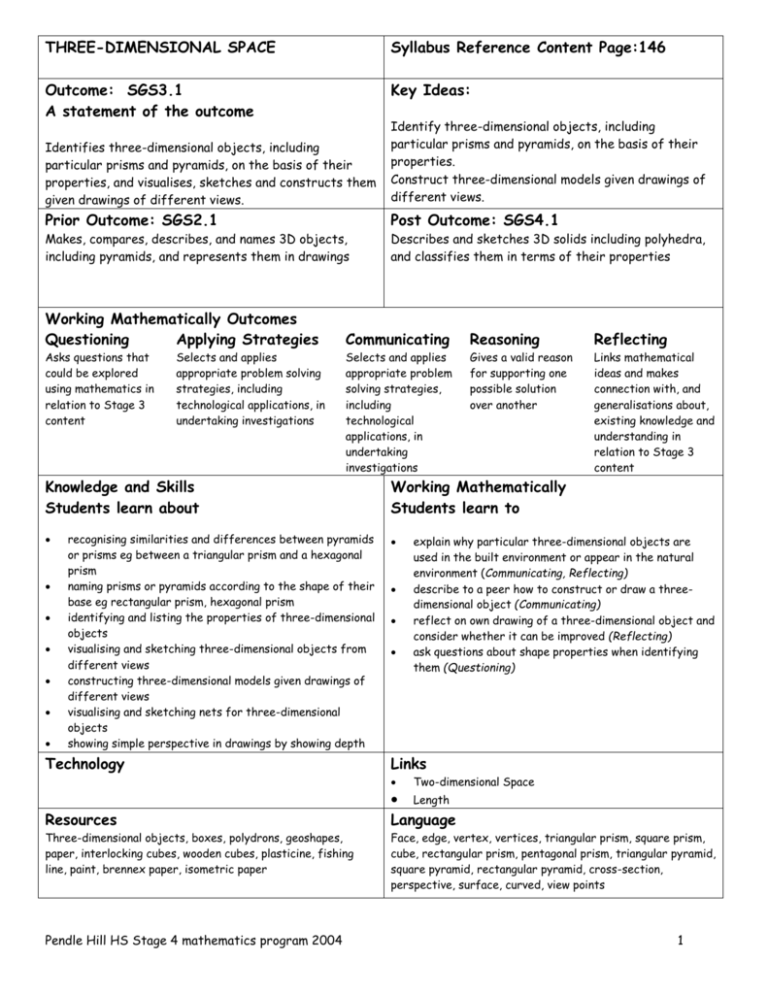
THREE-DIMENSIONAL SPACE Syllabus Reference Content Page:146 Outcome: SGS3.1 A statement of the outcome Key Ideas: Identifies three-dimensional objects, including particular prisms and pyramids, on the basis of their properties, and visualises, sketches and constructs them given drawings of different views. Identify three-dimensional objects, including particular prisms and pyramids, on the basis of their properties. Construct three-dimensional models given drawings of different views. Prior Outcome: SGS2.1 Post Outcome: SGS4.1 Makes, compares, describes, and names 3D objects, including pyramids, and represents them in drawings Describes and sketches 3D solids including polyhedra, and classifies them in terms of their properties Working Mathematically Outcomes Questioning Applying Strategies Asks questions that could be explored using mathematics in relation to Stage 3 content Selects and applies appropriate problem solving strategies, including technological applications, in undertaking investigations Communicating Reasoning Reflecting Selects and applies appropriate problem solving strategies, including technological applications, in undertaking investigations Gives a valid reason for supporting one possible solution over another Links mathematical ideas and makes connection with, and generalisations about, existing knowledge and understanding in relation to Stage 3 content Knowledge and Skills Students learn about recognising similarities and differences between pyramids or prisms eg between a triangular prism and a hexagonal prism naming prisms or pyramids according to the shape of their base eg rectangular prism, hexagonal prism identifying and listing the properties of three-dimensional objects visualising and sketching three-dimensional objects from different views constructing three-dimensional models given drawings of different views visualising and sketching nets for three-dimensional objects showing simple perspective in drawings by showing depth Technology Working Mathematically Students learn to Links Resources Three-dimensional objects, boxes, polydrons, geoshapes, paper, interlocking cubes, wooden cubes, plasticine, fishing line, paint, brennex paper, isometric paper Pendle Hill HS Stage 4 mathematics program 2004 explain why particular three-dimensional objects are used in the built environment or appear in the natural environment (Communicating, Reflecting) describe to a peer how to construct or draw a threedimensional object (Communicating) reflect on own drawing of a three-dimensional object and consider whether it can be improved (Reflecting) ask questions about shape properties when identifying them (Questioning) Two-dimensional Space Length Language Face, edge, vertex, vertices, triangular prism, square prism, cube, rectangular prism, pentagonal prism, triangular pyramid, square pyramid, rectangular pyramid, cross-section, perspective, surface, curved, view points 1 Learning Experiences and Assessment Opportunities Assessment for learning Students create a mindmap showing all they know about solids – teacher observes product and listens to discussion Students build models using various concrete materials Students complete individual solid group report – share answers with the rest of the class Students complete a card matching activity showing names of solids and diagrams At Stage 2 students are expected to be able to: Name, describe, sort, make and sketch prisms, pyramids, cylinders, cones and spheres Create nets from everyday packages Describe cross-sections of 3D objects Prisms Students are given a selection of prisms and pyramids to investigate the number of faces, edges, and vertices. They look for similarities and differences between the objects. Students construct a table to record findings. Name Faces Edges Vertices Triangular prism 5 9 6 Rectangular prism 6 12 8 Pentagonal prism 7 15 10 Square pyramid 5 8 5 Sorting and Classifying Three-dimensional Objects Students are provided with a variety of objects including multiple examples of prisms and pyramids. Students investigate the faces, edges, vertices and cross-sections. They record the following information in a table or list: the name of each object according to the shape of its base, a list of properties of each object, a sketch of a net of each object, a simple perspective drawing and a list of similarities and differences. Possible questions include: how could you improve your drawing? how could you classify the objects? Students write an explanation of the properties of each object. Different Views Students sketch different everyday objects eg buildings, power pole. They are asked to sketch a front, side and top view on separate cards. Students swap their sketches with a partner who names the object. Variation: The teacher collects the cards and photocopies them so that there are enough sets for the class to play a concentration game with the cards. In small groups, students place all the cards face down in the centre of the group. Each player takes a turn at turning over three cards. If the three cards turned over match the front, side and top view of one object then that player keeps the cards, but if they do not match then they are turned back over and the next student has a turn. The winner is the player who has the most cards when all the cards have been collected. Rectangular Prisms Students are given 24 interlocking cubes. They are asked to make a rectangular prism with a volume of 24 cubic units. They describe their rectangular prism in terms of its length, breadth and height and record this information. The teacher poses the question. ‘Can you make other rectangular prisms with a volume of 24 cubic units?’ Students attempt to do this, record the results and describe what they notice. Students draw a simple perspective drawing of each prism showing depth. Variation: Students make prisms with a variety of volumes and discuss. Pendle Hill HS Stage 4 mathematics program 2004 2 Barrier Game In pairs, students sit opposite each other with a barrier between them. Student A selects a three-dimensional object and describes how to draw it. Student B follows the instructions to draw the object. Both students reflect on the drawing. Students then reverse roles. Three-dimensional Viewpoints The teacher prepares cards that show the front, top and side view of various prisms. Students label each card, naming the view. They then use the cards to construct a three-dimensional model, naming it according to the shape of its base. Students display their labelled cards and models. The other students in the class match the model to the cards. Extension: Students make their own cards and repeat the activity. Construction Views Students collect a variety of three-dimensional objects eg boxes, cylinders. In small groups, they use the objects to build a tower. Students sketch the view from their own perspective. Each group shuffles the sketches and leaves them and the model on the table. Groups rotate to a new table where they sort the sketches according to the perspective. Possible questions include: What strategies did you use when sketching the tower? What strategies did you use to correctly match perspectives? Variation: Students deconstruct their towers leaving the objects on the table. The groups rotate and are given the sketches of the different views of the tower and rebuild it. Possible questions include: What strategies did you use to rebuild the tower? Construct a model Students are given 8 straws/pop sticks and blue tack. They construct a three-dimensional model using all 8 straws/sticks. Students display their models. Possible questions include: What is the name of your model? Can you list its properties? Students draw the model showing simple perspective. Variation: The number of straws could be varied. Commercially produced construction equipment could be used to produce other models. What Three-Dimensional Object Am I? Students select an object and write a description of its properties. Other students ask questions to identify the object eg ‘Does your object have 6 faces?’ ‘Are your object’s opposite faces equal?’ ‘Is your object’s base a rectangle?’ ‘Are your object’s faces rectangular?’ ‘Is your object a rectangular prism?’ Variation: Students make ‘What Object am I?’ booklets. Net Challenge Students are challenged to create all the possible nets for a cube. Students could use polydrons, grid paper or tiles to create the nets. Students are encouraged to decide if each solution is different or if it is the same net in a different orientation. Students record the nets on paper or by using a computer package. Variation: Students draw the nets of other prisms and pyramids. They find nets of other three-dimensional objects. Pendle Hill HS Stage 4 mathematics program 2004 3 Construct coloured cube See Curriculum Support article Object Hunt Students walk around the school and list 10 three-dimensional objects that they see. They record each in a table with the name of the object. Students compare lists and suggest reasons why particular three-dimensional objects occur in build and natural environments. Variation of Models The teacher draws a 4 x 4 grid on paper. Students are given a side and a front view of a model made with cubes. They make a model that conforms to the views eg Side View Front View Possible questions include: What is the most/least number of cubes you can use to make the model? Have you made the only possible model? How do you know? Variation: Students create their own three-dimensional model and then draw the side and front view. They swap the drawing with a partner who makes the model. Perspectives Students draw the school building showing perspective. They discuss their work and reflect on how they could improve their drawing. Variation: Students draw other things around the school showing perspective. Models Students are asked to use cubes to construct a three-dimensional model given a drawing of its top view. Students then sketch their model from other views. Extension: Students are asked to make and draw different models with this top view. Cube Puzzle Students are tole that a wooden cube that measures 3 cm along each edge is painted red. The painted cube is then cut into 1 cm cubes. Possible questions include: How many of the 1 cm cubes do not have paint on any face? How many of the 1 cm cubes have paint on just once face? How many of the 1 cm cubes have paint on just two faces? How many of the 1 cm cubes have paint on 4 or more faces? Three-Dimensional Models Students collect pictures of three-dimensional objects that occur in everyday life from magazines, papers or the Internet. In small groups, students classify the pictures into prisms or pyramids and list their similarities and differences. Each student then chooses one of the pictures and explains why that particular three-dimensional shape was used. The students choose a picture and draw a simple perspective drawing of an object in the picture eg rear of a building, side view of a house. Variation: In groups, students create a model of a three-dimensional object from the pictures using a variety of Pendle Hill HS Stage 4 mathematics program 2004 4 equipment eg papier mache, playdough. Cooperative Logic: Build it series Pendle Hill HS Stage 4 mathematics program 2004 5
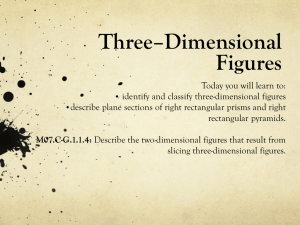
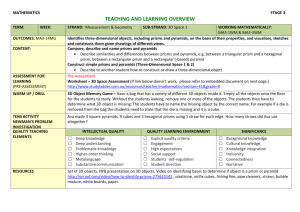
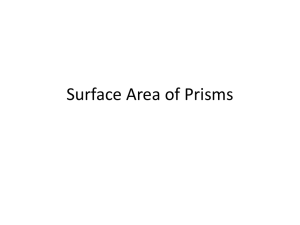
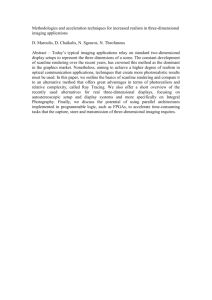
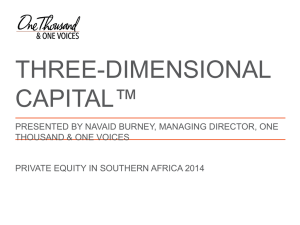
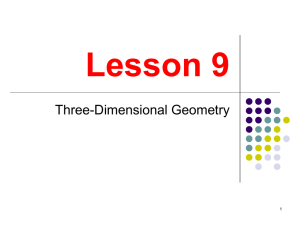
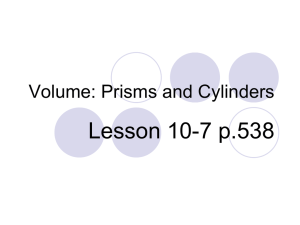
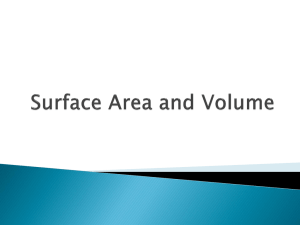
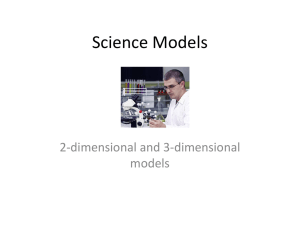
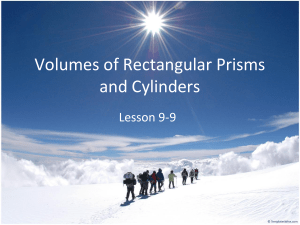
![Volume of Prisms and Cylinders [12/4/2013]](http://s2.studylib.net/store/data/005712570_1-e7691fc1893418ebe51c7a30e9e35d27-300x300.png)